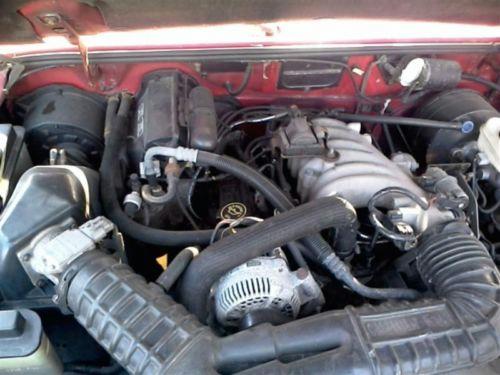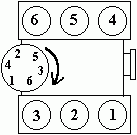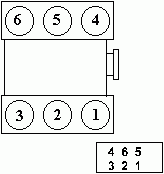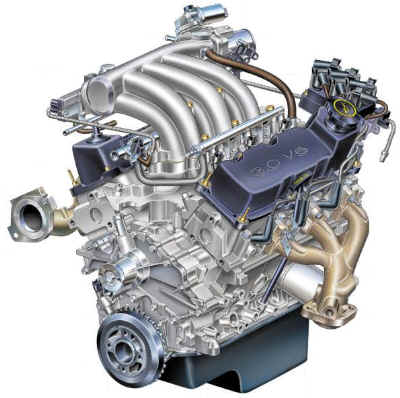
The Ford Vulcan V6 is a 3.0L, 60° V6 engine, first introduced for the 1986 model year and originally designed to be the optional engine in the Ford Taurus and Mercury Sable. In 1991 it became available in the Ford Ranger where it replaced the Cologne 2.9 engine (which it is not related to) as the base V6 in the Ranger.
The Vulcan was a clean-sheet design using the metric system. The engine block is built by Sherwood Metal Products, the intake comes from Ford’s Essex Casting, and the engine is assembled at Ford’s Lima Engine plant in Lima, Ohio.
The Vulcan is a straightforward pushrod design, with 2 valves per cylinder. Bore is 3.504 in and stroke is 3.15 in. The engine was designed to use electronic fuel injection from the start (there was never a carburetor-equipped version), and was also sold in a “flexible fuel” configuration that could burn normal gasoline, E85 (a blend of 15% gasoline and 85% ethanol) or any mixture of these two fuels.
In 1991, it was updated with lower-friction pistons, a strengthened block, roller camshaft and other changes that resulted in a power rating of 145 hp and a torque rating of 160 ft·lbs. In 1998 further improvements were made, with a new intake manifold, changes in engine management and cam timing; output was further increased to 155 hp (115 kW) and 185 ft·lbs. A plastic upper intake was added in 2001.
This engine has become very well-known for its durability and is common to find engines running strong at 300,000 miles and beyond.
2009 was the last year that the 3.0L V6 was offered in the Ford Ranger. The 3.0L EcoBoost is an entirely different engine.
|
Engine Specifications |
|
| Engine Displacement (Cubic Inches) | 183 CID |
| Block | Cast Iron 60º V-6 |
| Type | Over-head Valve Engine |
| Bore x Stroke | 3.50 x 3.14 |
| Compression Ratio | 9.3:1 |
| Valve Lifters | Hydraulic (1986 – 1993)
Hydraulic Roller Tappets (1994 – 2001)(Same as 5.0L) |
| Fuel System | Fuel Injection |
| Fuel Pressure | 30 – 40 PSI |
| Horsepower | 145hp @ 4800 RPM (1991 – 1995)
147hp @ 5000 RPM (1996 – 1997) 145hp @ 5000 RPM (1999) 150hp @ 4750 RPM (2000 – 2001) 146hp @ 5050 RPM (2002) 154hp @ 5200 RPM (2003 – 2004) 148hp @ 4900 RPM (2005-2009) |
| Torque | 165 @ 3600 RPM (1991 – 1995)
162 @ 3250 RPM (1996 – 1997) 178 @ 3750 RPM (1999) 190 @ 3650 RPM (2000 – 2001) 180 @ 3500 RPM (2002) 180 @ 3900 RPM (2003 – 2004) 180 @ 3950 RPM (2005 – 2009) |
| Oil Pressure | 40 – 60 PSI @ 2500 RPM |
|
Tune Up |
|
| Spark Plug | AWSF-32PP (Motorcraft SP432) |
| Spark Plug Gap | 0.044 inch |
| Ignition Timing | 10 degrees BTDC |
| Firing Order | 1-4-2-5-3-6 |
| Distributor Rotation | Clockwise (1991 – 1994)
Distributorless (1995 – Later) |
|
Capacities |
|
| Oil Capacity With Filter Change | 4.5 Quarts |
| Cooling System Capacity (Quarts) | W/AC- 10.2 / W/O AC 9.5 |
|
Torque Specifications |
|
| Cylinder Head | Torque in 2 steps [1st (33-41 ft-lbs), 2nd (63-73 ft-lbs)] (1991 – 1998)
Torque in 4 steps [1st (59ft-lbs), 2nd (loosen 1-full turn), 3rd (34-40ft-lbs) 4th (63-73ft-lbs)] (1999 – Later) |
| Main Bearing Bolts | 60 ft-lbs |
| Rod Bearing Bolts | 26 ft-lbs |
| Crankshaft Pulley Bolts | 107 ft-lbs |
| Flywheel to Crankshaft Bolts | 59 ft-lbs |
| Upper Intake Manifold / Throttle Body | 19 ft-lbs |
| Exhaust Manifold | 19 ft-lbs |
|
Miscellaneous Specifications |
|
| Bore Spacing | 4.33 inches |
| Connecting Rod Length | 5.53145 inches |
| Block Height | 8.661 inches |
| Piston Compression Height | 1.5354 inches |
| Main Bearing Journal Diameter | 2.5194 inches |
| Connecting Rod Journal Diameter | 2.1257 inches |
Firing Order:
1991-1994 Firing Order 1-4-2-5-3-6

1995-2008 Firing Order 1-4-2-5-3-6


Jim Oaks is the founder of TheRangerStation.com, the longest-running Ford Ranger resource online since 1999. With over 25 years of hands-on experience building and modifying Ford Rangers — including magazine-featured builds like Project Transformer — Jim has become one of the most trusted authorities in the Ford Ranger off-road and enthusiast space. In 2019, he was loaned a Ranger FX4 by Ford Motor Company to test and document across the TransAmerica Trail. Jim continues to inspire and guide Ranger owners around the world.
